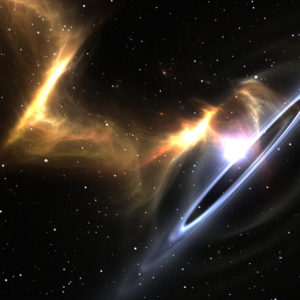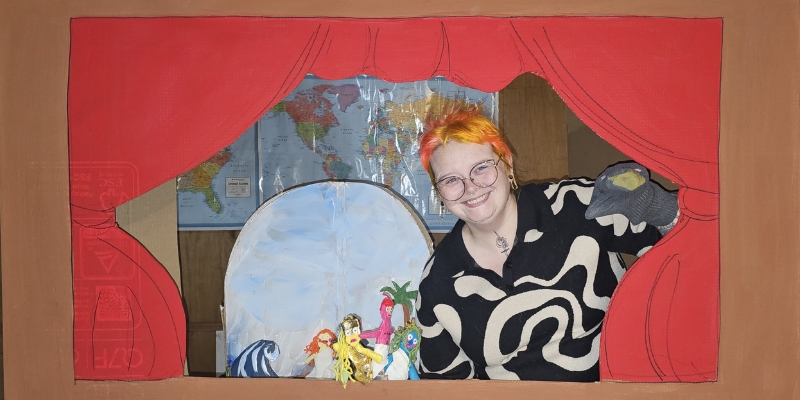What can a black hole teach us about the history and future of our universe? How well did the movie Interstellar capture the science of black holes? Are black holes black? Chris Impey, a distinguished professor in the Department of Astronomy at the University of Arizona, will be joining us November 15 at the Museum of Flight to discuss his new book, Einstein’s Monsters: The Life and Times of Black Holes.
In the meantime, Town Hall’s Jonathan Shipley had a chat with Impey about space’s great wonder, the Theory of Relativity, and how dumb that Disney movie, The Black Hole, was.
JS: For the layperson – what IS a black hole?
CI: A black hole is an object so dense that the escape velocity exceeds the speed of light, meaning that nothing can get out. The event horizon marks the edge of the region where everything is trapped. A black hole is a situation where space is so curved that a piece of the universe is pinched off. Black holes range in mass from a few times the mass of the sun to over ten billion times the sun’s mass.
JS: Why are they important to study?
CI: Black holes provide the ultimate tests of general relativity. This gravity theory is very successful but it’s only been tested where gravity is weak, so confidence in the theory will grow if it can predict and explain the bizarre properties of black holes. Massive black holes are the keys to understanding how galaxies form and evolve. Black holes may also show how to derive a theory that reconciles gravity with the behavior of subatomic particles.
JS: What would happen to you if you went into one? What would it be like to your senses?
CI: A person could not survive passing into the type of black hole that results when a massive star dies. They would be spaghettified, bones and muscle fibers stretched to the breaking point. The event horizon is not a physical barrier; a person falling in would see extreme distortions of space and time as they met their fate.
JS: What movie best captures black hole science?
CI: The best black hole movie of recent times was Interstellar (2014). It boasted a pre-eminent scientific advisor in physicist Kip Thorne of Cal Tech, and computer simulations of spinning black holes were run to generate the CGI graphics. The science, like space and time itself, is stretched to the limit but not broken.
JS: What movie was the worst at it?
CI: Disney’s Black Hole (1979) gets a partial pass for when it was made but otherwise it’s in the category of scientific implausibility and very cheesy dialog. It’s notable for being Disney’s first non-PG movie. Tied for worst is Event Horizon (1997), with a premise of creating a black hole for space travel, but then somehow manages to invoke Hell and adds a lot of ridiculous plot devices and melodramatic acting.

Disney’s “The Black Hole”, 1979.
JS: Are black holes black? If not, what color are they?
CI: They are essentially black because no light can escape. However, they are not totally dark because, according to Stephen Hawking, they emit a tiny amount of radiation causing them to very slowly evaporate. Hawking radiation is too cold to have a color.
JS: How have black holes confirmed Einstein’s Theory of Relativity?
CI: Black holes have been used to demonstrate the warping of space and the slowing of time that happens near the event horizon. Gravitational red shift has also been seen, where photons lose energy climbing out of the intense gravitational field. The detection of gravitational waves from binary black holes confirms not only the existence of black holes but also a key prediction of general relativity.
JS: What happens when black holes meet?
CI: Black holes do not often meet, since they are the remains of rare massive stars, and then only the subset where two stars are in a close binary orbit. They get closer due to the release of orbital energy as gravitational radiation, accelerating the merger. After this slow crescendo of gravitation waves, there is a torrent as the black holes merge, followed by a slow “ring down” phase. The math of black hole merger is that the mass of the merged black holes is less than the sum of the two masses, due to the release of gravitational waves. Somewhere in the universe two black holes merge every second.
JS: Every galaxy has a black hole. Why?
CI: Every galaxy has a black hole, with a mass roughly proportional to the total mass of old stars in the galaxy. This fact suggests that black holes play an important role in the evolution of galaxies. The black holes are inactive most of the time, but feed on gas and stars in the central region of a galaxy and flare into activity. Galaxies and their central black holes grow together, but it’s an open research question which came first, the galaxy or the black hole.

Woah.
JS: You wrote that black holes “distort space and time very close to their event horizons.” Can you unpack that a bit more for me, a layperson?
CI: General relativity says that mass curves space, and so gravity is just the response of a moving object to the curvature of space. This curvature is subtle for a small object like the Earth or a low density object like the Sun, but the fantastic density of a black hole amplifies the effect. The event horizon corresponds to the place where the distortion is so extreme that light is bent back on itself and so cannot escape.
JS: What drew you to the study of them?
CI: I got into black holes through the study of active galaxies and quasars. These are galaxies harboring supermassive black holes in a highly active state, where the accretion of matter and subsequent particle acceleration causes strong radiation across the electromagnetic spectrum. These are the most luminous objects in the universe. Black holes get as big as ten billion times the mass of the sun. Who could resist studying them?
JS: What can a black hole tell us about our past? Our future?
CI: Black holes are mute to the past, in the sense that they conceal what went into them. They can only form by the violent compression of matter. There is no black hole in our past, nor any in our immediate future, because the Sun will die instead as a white dwarf. But they do tell of the future of the universe since they embody entropy and disorder, and that is the ultimate fate of matter and the cosmos.
Don’t miss Impey’s event on 11/15 at The Museum of Flight.



